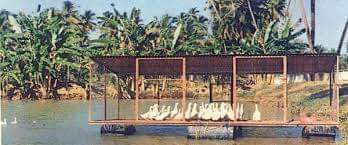Ducks occupy an important position next to chicken in India. According to 19th Livestock census 2012, they form about 3% of the population in India. In India ducks are reared both for meat and egg. Ducks breed like Crested white, Black east India, call etc. Are used for ornamental purpose. The incubation period of duck is 28 days. Ducklings can be reared in intensive, semi intensive or range system.
Advantages of duck farming:
• Duck lay more egg per bird per year than chicken.
• Duck lay bigger size egg than chicken.
• Duck require less attention and thrive well in scavenging condition.
• Less money is requires in feeding ducks. They eat fallen grains in paddy field, insects, snails, earthworms, small fishes and other aquatic materials.
• Ducks have a longer profitable life. They lay well even in second year.
• Like chicken duck do not need elaborate housing.
• Ducks are quite hardy, more easily brooded and more resistance to avian diseases.
• Marshy river side, wet and barren land which are un useful can be use for duck farming.
• Ducks lay 95-98% of their eggs in the morning before 9.00 am. Thus saves lot o time and labour.
• Ducks are suitable or integrated arming system such as duck cum fish farming, duck farming with rice cultivation. Under integrated duck farming with rice cultivation ducks perform essential function like inter tillage as they search or food, their bills loosen up the soil around the ice plant weeding, inset control and manuring.
• Ducks are quite intelligent, can be tamed easily, and trained to go to pond and come back in the evening on their own.
Breeds of duck that can be reared.:
Egg type breed consisting of khaki Campbell and Indian runner breed and meat type breed are white pekin, Muscovy and Aylesbury.
Duck rearing system.:
Duckling can be reared in
1. Intensive system
Under intensive system ducks are reared on deep litter till they attain the age of 16 weeks. A confined space is allowed per bird. As the duckling become 17 weeks they are vaccinated. In this system duckling grows at a faster rate and therefore require ration rich in all nutrition.
2. Semi –intensive
Under semi intensive system, birds are grown in deep litter floor. Here local feeds are also made use off. Some amount of ration is replaced by cheaper vegetables feeds household scrapes and fodder.
3. Range system
In free range system, duckling are provided ample space for run and in night shelter. Here ducks obtain most of their protein needs by foraging from small fish, crustaceans and insects.
Duck feeding.
Duckling feeding:
Duckling should be fed as they are removed from the incubator to the brooder or immediately after they are received from the hatchery. Extreme care should be given to them for the first few days to save them from dying or starvation. It is necessary to hand feed the duckling for first few days. Duckling feed should consist of milled cereal (35%), fine cereal bran (30%), fish or meat meal (20%), extracted oil cake meal (10%), fine grit and mineral (5%).
Feeding growers and layer:
Feeding duck requires much care. Feed stored under high relative humidity get poisoned due to fungal growth. To avoid feed toxicity, feed may be formulated by eliminating maize and ground nut cake as far as possible. Broken rice, damage wheat, soybean meal etc. can be included in formulating the feed. Fish meal should of good quality.
Common duck disease:
1. Duck plague.
2. Duck cholera
3. Aflatoxicosis
4. Botulism
5. Internal parasite
6. External parasite
Birds loose appetite, poor feed intake, poor growth, dullness, lameness, drooping wings, labour breathing, coma, high body temperature, diarrhoea followed by mucoid dropping. To prevent vaccine first at age of 4 weeks and again at 16 weeks with duck cholera vaccine give c-type antitoxin . To control antibiotic should be used, remove rotten vegetation, give proper feed and clean water, maintain cleanliness in the farm. Dead birds should be burned
Conclusion:
The current scenario reveals that duck farming significantly contribute to farmer livelihood in term of nutrition and income. Farmer should focus on intervention of improved breed which thrive well in rural areas and will enhance the income to famer livelihood and in tern reducing poverty and increasing food security. The rapid growing demand for duck meat and eggs can be thrived by adopting of duck farming in rural areas. The farmer also must be given training on duck farming to equip them with relevant skills to merge scientific methods for improving their productivity.
By- Shahnur Rahman, 4th Year, B.V.S.&A.H., Lakhimpur College of Veterinary Science,
Assam Agricultural University, Johying, North Lakhimpur,Assam-787051, India
Email Id: shahnurrahman020@gmail.com,
Cell:+91-9957625850



